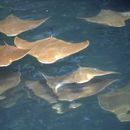Diagnostic Description
provided by Fishbase
Deep grove around front of head below eyes; forehead above groove indented, snout below groove is distinctly bilobed (Ref. 26938). Disk brown to olive above, with no spots or marks, wings long and pointed (Ref. 7251). Lower surface white or yellowish white (Ref. 6902).
- Recorder
- Grace Tolentino Pablico
Life Cycle
provided by Fishbase
Exhibit ovoviparity (aplacental viviparity), with embryos feeding initially on yolk, then receiving additional nourishment from the mother by indirect absorption of uterine fluid enriched with mucus, fat or protein through specialised structures (Ref. 50449).
Migration
provided by Fishbase
Oceanodromous. Migrating within oceans typically between spawning and different feeding areas, as tunas do. Migrations should be cyclical and predictable and cover more than 100 km.
Trophic Strategy
provided by Fishbase
A benthopelagic species found on continental and insular shelves; enters bays and estuaries; forms huge schools inshore (Ref. 114953). Jumps occasionally, landing with a loud smack, probably as a territorial display. Migrates south in large schools that disappear off northern Florida, USA and are not reported from Caribbean Is.; tagged fish have been recovered in northern South America (Ref. 7251). Population in the Gulf of Mexico migrates clockwise; schools of up to 10,000 rays leave west coast of Florida for Yucatan, Mexico in the fall (Ref. 7251). Foraging schools of rays invade tidal flats during the flood tide. Stirring motions of the pectoral fins combined with suction from the expansive orobranchial chamber are probably used to excavate deep burrowing bivalves (Ref. 59106). Adult rays feed on deep burrowing mollusks and juveniles feed on shallow or non-burrowing bivalves (Ref. 59106). The soft shell, Mya arenaria, contributed the greatest frequency of occurrence (Ref. 59106). Exposed pectoral fin tips and water boils on a calm surface was characterized the shallow-water feeding activity of cownose rays (Ref. 59106).
- Recorder
- Arlene G. Sampang-Reyes
Biology
provided by Fishbase
A benthopelagic species found on continental and insular shelves; enters bays and estuaries; forms huge schools inshore (Ref. 114953). Feeds mainly on benthic invertebrates and molluscs (implicated in damaging seagrass beds) (Ref. 93252, 114953). Jumps occasionally, landing with a loud smack, probably as a territorial display. Migrates south in large schools that disappear off northern Florida, USA and are not reported from Caribbean Is.; tagged fish have been recovered in northern South America (Ref. 7251). Population in the Gulf of Mexico migrates clockwise; schools of up to 10,000 rays leave west coast of Florida for Yucatan, Mexico in the fall (Ref. 7251). Ovoviviparous (Ref. 50449).
Importance
provided by Fishbase
fisheries: minor commercial; aquarium: public aquariums; price category: medium; price reliability: very questionable: based on ex-vessel price for species in this family

